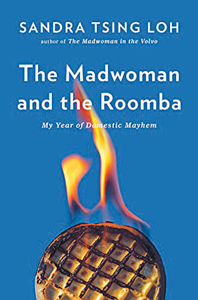The Madwoman and the Roomba, by Sandra Tsing Loh (W.W. Norton, 276 pages)
Can we say that it’s a little more than ironic that a woman who found fame leaving the stifling prison that was a 20-year marriage is now rhapsodizing affectionately about the “domestic mayhem” that is her life?
But that is where Sandra Tsing Loh has arrived 11 years after the publication of her celebrated Atlantic piece titled “Let’s Call the Whole Thing Off,” which was an explanation of why she ended her marriage and an invitation for other people to do the same.
A year earlier, she’d found fame and acclaim for Mother on Fire, an acerbically funny memoir of parenting, and many of her fans were surprised to find her ringless a year later, although it did much for her career. I tend to be stoutly judgmental about such things, but I’m willing to forgive a lot for a laugh, including “Let’s Call the Whole Thing Off” and another mildly disturbing Atlantic essay in which she said she wished her 91-year-old father would die. That’s probably a character flaw in me, which is why I like Loh even as she tramples on my fundamental values. She has plenty of her own, on public display in two books that portend a long-running series, 2014’s The Madwoman in the Volvo, My Year of Raging Hormones and now, The Madwoman and the Roomba, My Year of Domestic Mayhem.
There is a pleasant afternoon to be had envisioning what comes next: The Madwoman in the Face Mask? The Madwoman and the AARP? The Madwoman and the Depends? Loh (pronounced “low”) has built a devoted following, so it’s a safe bet that Roomba won’t be the last. Loh, who the New York Times once crowned a worthy contender for “publishers’ holy grail, ‘the female David Sedaris.’” Like Sedaris, she is reliably funny and specializes in understated comedy built around the adventures of a strange family that feels vaguely familiar but, under the microscope, is really nothing like yours. (How unlike yours? Her father, for starters, had a rock song written about him by a band named Boy Hits Car. The song contains the line “Mr. Loh’s not afraid to be naked.” There you go.)
But she imagines herself this red, white and blue everywoman, trying earnestly to be one of “us” rather than one of the dastardly “them,” all the while showing that she’s not really poor and struggling, but just seems to have too many stupidly rich friends. As a technique, this is generally opaque, and she wears peasant clothes well in one of the stronger chapters in the book, titled “Stanford Swimming.”
In the essay, Loh makes comic hash out of an evening spent with friends at a New York estate that “looks like a large villa you’d find in Europe, protected by lush non-native hedges.” The friends, of course, are “thems” and if you hadn’t already figured this out, you will when the wine comes out and the friends say, winsomely, that it isn’t expensive but was on the Zagat list of “great wines under $40.”
“Charlie and I raise eyebrows amusedly at each other. For us the price cap on a bottle of wine is eight dollars,” Loh writes. The next nine pages are essentially “Mr. Smith Goes to Washington” had Mr. Smith been sardonic, an easy-going, fish-in-a-barrel takedown of people who have personal cooks and tennis courts and sons who win swimming scholarships to Stanford. Loh, in comparison, says that she’s not even sure her teenage daughters can swim, and they come to the table, one looking like an L.A. gang girl “edging into drag queen,” the other a “painfully thin” child evocative of Ichabod Crane who is “less eating her salad than worrying it.” She worries that when lacrosse is mentioned, her daughters will think the conversation is about sparkling water.
“Stanford Swimming” is one of the longer essays in a collection that ostensibly runs the length of a year, Loh’s 55th. As Madwoman in the Volvo was about menopause, it’s more difficult to define what Madwoman and the Roomba is about, other than maybe trying to pay off a tax bill born of an IRS audit detailed in a chapter called “A very Hindu audit.” It’s here, among other places, that Loh’s everywoman credentials seem just a tiny bit overstated, as she exclaims worriedly about the IRS challenging $25,000 in business expenses and says she only gets massages when Groupon is involved.
There is a lot of exclaiming in this book. There also are a worrisome number of exclamation marks, making it seem that a stern editor wasn’t one of those business expenses, and an overabundance of Loh’s trademark dashes, which she seems to use as a calling card and a stand-in for ellipses. Example from a bit of dialogue: “‘You cannot lumber after waiters like an extra from The Walking Dead, knocking over priceless Louis Quatorze art along the way —’”
It’s a small quibble, and maybe you love it, but David Sedaris doesn’t do it.
At the end of the year Loh’s father finally dies, and at first she seems to have all the remorse and grief that you would expect of someone who has been grousing for years about why he had the nerve to live so long, given the “giant money leakage of his care.”
There is an important conversation to be had about whether science is extending life for too long, and Loh’s most shocking statements may be more shrewd calculations than heartfelt emotions; her undergraduate degree, after all, was in physics. But the reader still has the right to be shocked when, upon going to her father’s house soon after his death, Loh decides to take a selfie with her father’s corpse. Is this a thing? If so, it would seem more the action of a millennial than a baby boomer “at the dropping tail of the boom.”
It’s hard, however, to dislike any writer who calls a mortuary professional a “Styx crosser” regardless of other offenses. A-
BOOK NOTES
Since The New York Times once said Sandra Tsing Loh (reviewed above) was a candidate to be “the female David Sedaris,” it seems appropriate to see who else has earned this honor, and more importantly, whether they’re in paperback so we can take them to the beach.
Sedaris, of course, is the sly humorist made famous in 1992 by an essay about playing one of Santa’s elves at Macy’s, the broadcast of which is now an NPR holiday tradition. His books, which include Me Talk Pretty One Day and Let’s Explore Diabetes with Owls, seethe with weapons-grade humor softened by a folksy tone and a surprising depth of wisdom and lived pain.
Why do we need a female Sedaris? Hard to say because there is no equivalent search for a male Anne Lamott.
But the contenders, according to Google, include not only Loh but these authors:
Lauren Weedman,Miss Fortune (Plume, 304 pages)
Sloane Crosley, I Was Told There’d Be Cake (Riverhead, 230 pages)
Susan Reinhardt, Chimes from a Cracked Southern Belle (Grateful Steps, 384 pages)
Susan Jane Gilman, Hypocrite in a White, Pouffy Dress(Grand Central Publishing, 369 pages)
Faith Salie, Approval Junkie (Three Rivers Press, 288 pages)
Jen Lancaster, Bitter is the New Black, (Berkley, 416 pages)
To be fair, there are others, but some women seem to have given the title to themselves on their blogs. I make no guarantees as to how Sedarisian these women are, but note that Crosley has especially good reviews.
Or you could just wait for a new Sedaris book to come out. The New York Times recently reported that there are two in the queue, The Best Of Me, a collection of previously published essays, due out in the fall (pandemic willing), and Carnival of Snackeries, more selections from the diary he has kept for more than 40 years, scheduled next year.





